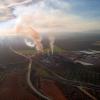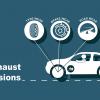Press Releases
Displaying Results 1 - 25 of 38
Faced with increasing impacts of climate change, pollution and biodiversity loss, which together constitute the “triple planetary crisis”, no country can act alone. Like nature itself, these challenges know no borders, which makes international cooperation a crucial part of action to address them
Multilateral Environmental Agreements (MEAs) will be at the forefront of discussions at the sixth session of the United Nations Environment Assembly (UNEA-6) on how to tackle the triple planetary crisis.
Executive Secretary Tatiana Molcean will lead a UNECE delegation to UNEA-6, the world’s
Nitrogen, which is vital for plant growth, is present in animal excreta and synthetic fertilisers that are applied to land to boost crop production. But excessive and inefficient use of this nutrient means up to 80% of it leaks into the environment, mostly in various polluting forms of nitrogen:
Parties to the UNECE Convention on Long-range Transboundary Air Pollution (Air Convention) have agreed to work to revise the Protocol to Abate Acidification, Eutrophication and Ground-Level Ozone (Gothenburg Protocol), which is expected to further strengthen efforts to reduce air pollution in
The decrease of air pollution achieved since the 1990s thanks to measures adopted under the Air Convention is leading to ongoing biological recovery from acidification in freshwater environments in Europe. This is the main finding of a new report published in the framework of the International
Each year, across the pan-European region, an estimated 1.4 million deaths are linked to environmental risk factors, including pollution and climate change. To accelerate collective commitments for healthier people and a sustainable future, Ministers and representatives of pan-European countries
The accurate measurement of vehicles’ tailpipe emissions, a key element in governments’ policy decisions and consumers’ choices to reduce the impact on air quality and the environment, will be significantly enhanced thanks to the adoption today of the United Nations Regulation on global Real
Following strong reduction from exhaust particle emissions (PM 2.5 and 10) over the past 20 years, due to international and national vehicle regulations, non-exhaust sources now make up approximately 80% of particle emissions from vehicle use, compared to some 40% in 2000. Non-exhaust emissions
The interlinkages between air pollution and climate change are manifold, even though discussions at the international level tend to often take place separately: air pollutants and greenhouse gases are often emitted by the same sources, leading to complex chemical interactions in the atmosphere. A
Updated guidance published today by the United Nations Economic Commission for Europe (UNECE) will help governments to strengthen biodiversity monitoring as a basis for sharpened biodiversity protection policies across all sectors.
The guidance is the first of its kind to build on the historic
A new report on the effectiveness of international cooperation on cleaner air in the framework of the UNECE Convention on Long-range Transboundary Air Pollution (Air Convention) shows that while emission reductions have been achieved, countries in the Pan-European region and North America are set
New research on the Costs of Inaction on air pollution reveals that in nearly half (26) of 56 countries in the Pan-European region and North America, the current monetary damage cost to health, ecosystems and the economy due to ambient air pollution corresponds to over 5 per cent of GDP. In at
Global biodiversity is now declining faster than at any time in human history. As leaders gather for the 15th Conference of Parties to the Convention on Biological Diversity (COP-15, 7-19 December), UNECE calls for the region to urgently step up with the leadership needed to stop biodiversity loss
Ecosystems such as forests, heaths and surface waters are more sensitive to atmospheric nitrogen pollution than previously thought, according to a new report published by the Coordination Centre for Effects under the UNECE Convention on Long-range Transboundary Air Pollution (Air Convention).
The
New assessment reveals progress on air quality and protected areas, but calls for urgent action to tackle emissions, waste, pollution and biodiversity loss
A circular economy and sustainable infrastructure offer solutions
Despite progress in certain areas, governments in the pan-European
While agriculture and food production cause significant air pollution, air pollution can also have significant impacts on crops, other vegetation and entire ecosystems. This, in turn, can impact on agricultural yields and food production and can lead to significant economic losses.
To review new
Heavy metals such as mercury have led to great harm to human health and the environment, for example in the 1950s in Minamata, Japan, when the release of methylmercury in the industrial wastewater from a chemical factory poisoned many people. Even in smaller quantities, heavy metals released into
Developed in the first half of the 20th century, persistent organic pollutants (POPs) have been regulated or banned as widespread public concern over their toxicological effects for human health and the environment has increased. Research has shown that exposure to POPs can lead to serious health
Almost 2 years into the pandemic, we have all experienced long and repeated lockdowns. Recent news from New Delhi, however, tell us that the city has gone into another lockdown – this time because of heavy air pollution.
Winter is also the season when air pollution problems in the UNECE region
Human-caused methane emissions are rising, and must be reduced by 40 to 45 per cent by 2030 to limit global temperature rise to 1.5° C, warned the Global Methane Assessment released last month by the Climate and Clean Air Coalition (CCAC) and the United Nations Environment Programme (UNEP). This
Over the past 20 years, international and national vehicle regulations have introduced increasingly stringent ceilings on particulate emissions (PM 2.5 and 10) from vehicles’ exhaust.
As a result, according to the emission inventories submitted by countries to UNECE’s Convention on Long-range
Nitrogen (N) is essential for life. It is an element of chlorophyll in plants and of protein (amino acids) in animals and humans. As such, it is a major nutrient to allow food, fibre and biofuel production.
However, human activities over the last century (use of synthetic inorganic N fertilizers
Pollution in the air is not only harming human health and the environment but is also degrading surfaces of historical buildings and monuments. The impact of dirty air on materials is enormous and can destroy our cultural heritage, an important component of our individual and collective identity
When 32 Member States signed the Convention on Long-range Transboundary Air Pollution in 1979, it was not evident that it would develop into a successful regional framework for controlling and reducing the damage to human health and the environment caused by transboundary air pollution. Yet, the
Air pollution kills 7 million people every year according to WHO data. It is by far the world’s largest single environmental health risk and a leading cause of death by cancer. Air pollution is also closely linked to climate change and is a major cause of environmental degradation,






















